So one week I was out with my comp, we traveled to Glenwood, where a favorite Elder of mine, Matt Sherrill transferred over from Boulder to Glenwood Springs, our neighboring area and the only other missionaries in our District. Sherrill and I were in Boulder with separate comps but the missionaries are the tightest in Boulder, since it’s such a weird and wild place, plus they lived two blocks away. So we made it a point to have a companion switch at least once or twice a week with these clowns. P-days were the best time to do these. I’d leave Charlie with another Elder and Sherrill and I would go wildlife watching in the mountains (bighorn sheep below Buford), (elk in the Harvey Gap range) and of course, huge spawning brown trout on the Colorado, Roaring Fork and Frying Pan rivers.
Just a quick side note: Sherrill even took me to the grave of Doc Holliday, of Tombstone gunwars and Wyatt Earp fame. The gravestone has his name on it, and always has a bottle of half empty Jack Daniels Tennessee Whiskey with a nipple on it. Each visitor inverts the bottle and squeezes a drop or two into the ground, so that Doc’s appetite for liquor never drowns out. Weird ritual, but everyone does it.
Well on one of these occasions, Sherrill started callin’ me “Eagle Eye”, because I’ve been blessed with good eyesight, and can usually spot an animal a long way off. This heightened sense helped me to spot a cheetah chase a gazelle in Africa. It helped me mark two great white sharks tailing a baby Humpback in Australia, and also to see sharks feeding on a dead turtle on Fraser Island, Queensland.
I told you THAT story to tell you THIS story, so this has a point, most indeedy. Last night, I was flipping through channels looking for something entertaining to watch. Sunday night in the fall always has a football game or something, but it’s the middle of winter now. I stopped on Channel 7, the local channel for Public Broadcasting System. Ever since I was a kid, “Nature” has been on for my viewing pleasure. Last night’s episode was about Raptors. No, not those monstrous devil lizards from Jurassic Park. More like raptors of the sky, meaning birds of prey. It was a well written program, and presented the information in a style that was familiar to me. The story began with the Legend of Icarus, and his desire to fly like a bird. It moved onto how eagles, vultures, hawks and owls fly, hover, manipulate and exploit the wind to increase their speed and energy while in flight. These birds caught on film, coupled with special effects from computers, instruct viewers on how these birds are able to pull off amazing feats of high-speed chases, detection through the elements, and how incredible their senses are.
I once listened to a hollow-minded and less educated teacher in junior high school tell me that animals do not see in color. I asked, “What about birds?” He told me that birds only have built-in telephoto lenses in their eyes, but couldn’t see in color. I knew, KNEW he was wrong. I was able to show him the facts on raptors with a few books from the school’s media library. I really hope he was watching last night’s program, too.

The American Kestrel sees ultraviolet light, and detects rodents through seeing their urine patches. Apparently, rodent urine gives off tremendous UV lights, and this makes it easy for raptors to find these creatures to prey on. The kestrel sees 350 more colors than the human eye can. The kestrel also has an amazing ability to hover in the air, resting comfortably on a current of hot air, also called a thermal. The uncanny trick, is that while his body is trying to stay aloft in the same place, his vision is perfect and unblurred. I have seen this MANY a time, and would suggest to you fine people to take a look and keep your eyes peeled to the sky for these birds, the smallest of the birds of prey.
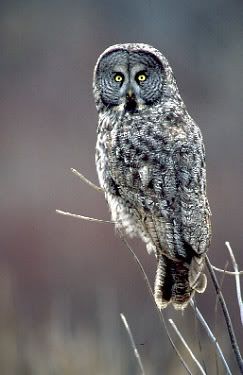
This next bird is my favorite of all the owls: the Great Grey Owl.
Al and I were fishing the Lower section of the Tabiona ranch when we spotted two of these large strigidae. They were using a cavity of a tree trunk to house their nest. We spotted two babies, and two adults. Interestingly enough, these birds do NOT migrate, so if you like spotting owls, head to wooded areas where you can patiently wait and listen. These birds have extremely sensitive hearing and eyesight. They are also very quiet fliers.

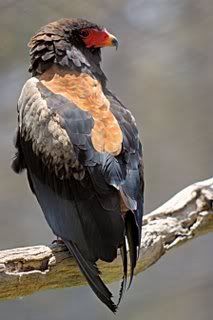
The bateleur isn’t the most amazing eagle in the world, but the reason I am showcasing this bird is because of how beautiful it is to spot one in the wild. Their profile against a blue sky in the savanna of Kenya is truly an amazing sight! These small eagles, along with Marabou Storks, and mwewes (small African kites) frequent Nairobi, always looking for lizards, snakes and rodents. They keep things interesting in the city and slums.
The Lappet-faced vulture is a giant among other vultures. The Lappet’s size and wingspan makes other raptors look like sparrows. This vulture is found only in Africa. Hollywood has always made idiots of themselves when using vultures in film. They don’t use Turkey or Black vultures, but Hooded or Lappet-faced vultures. In fact, the vultures you see laughing on Splash Mountain as Disney World are carbon copies of the largest African vulture. The first picture is of a Lappet-faced. Beautiful birds in flight, ugly as Yoda up close. I have an amazing picture of a Lappet landing in a high tree, just above the Mara River in Western Kenya. 200 feet below it was a 14 foot Nile crocodile, and about 5 hippos.
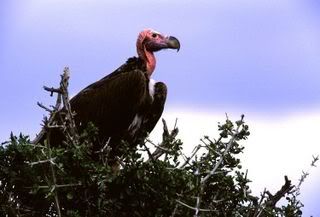
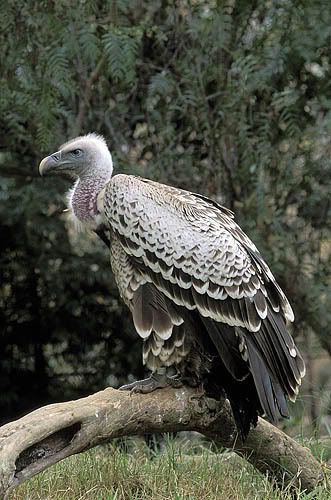
This is an African vulture. I think these bad boys are the coolest looking birds in the world. They just have a mean looking face!
And when it comes to vultures, Africa wins. North America has the ugliest raptor in the world, the turkey vulture. When you see a large bird circling in the wind on a hot day, chances are that you will be seeing a turkey vulture. They usually hang out in groups as well, especially when there is a carcass around. Here is the ugly Turkey Vulture. No, I do not think they have a face a mother could love.
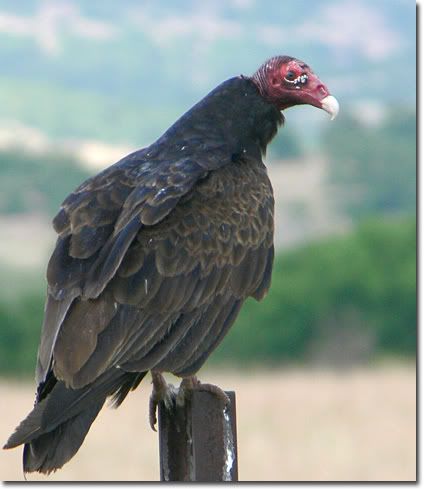
The fastest animal in the whole wide world, easily surpassing the sail fish and cheetah, is the Peregrine Falcon. My father and his twin brother found a P falcon when they were young. They found it in Fairmont Park, in SLC. They named it Odin, of Norse mythology. They kept it in the white coop in Grandpa Wright’s backyard, I think. How lucky my dad was to find such a beautiful creature.
The Peregrine can dive up to speeds past 200 mph in pursuit of game birds such as sage grouse, ducks, doves and whatever else it wants to chase. John and I saw a peregrine chasing a Mourning dove in City Creek canyon, not 20 feet between us in the river corridor. I’ve seen the peregrines downtown in SLC chasing the pigeons all over the place. Side note: the peregrines have nests on the buildings in Temple Square, and all the pigeons live on the Cathedral of the Madeline. That’s a metaphor for the Mormon falcons being the top dogs and regulators of SLC over the Catholic pigeons. Ha ha ha. Nature is funny, isn’t it? ;)
If you are ever in downtown SLC and have some time to kill, look up in the sky and try and pick out one of these small falcons. They are amazing fliers and they just sizzle through the sky as they drop, maneuver and twist through the different buildings in search of slower birds.
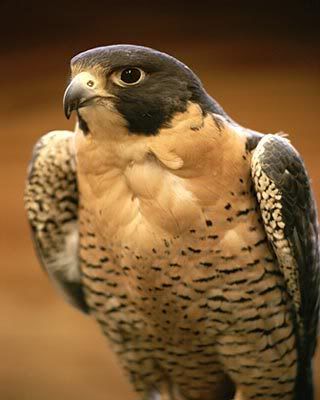
Birds of prey are protected in the United States. Please don’t kill them. If you get caught, you will spend 5-20 years in Federal Prison for doing so. Take advantage of a drive down a dusty road and look for birds on fenceposts, telephone poles, tree branches, telephone lines and other high structures. I keep a pair of binoculars with me at all times in the car when I am in rural, desert or mountain areas. I am humbled to have earned the nickname "Eagle Eyes" from my friend. I love driving through certain parts of the country, specifically past Strawberry Reservoir to watch Bald Eagles and Ospreys pick off trout in the water. I love the Golden Eagles just above the U of U on the East bench of SLC. Star Valley, Wyoming has more raptors than any other area I have been to in the West. There are Golden eagles, hawks, owls and falcons all over the place in Wyoming. I especially love the raptors of Africa too. The bateleur, African Fish Eagle and Tawny Eagle. Someday, I wish to see the great Harpy Eagle as well. The Steller's sea-eagle is what the Seattle Seahawks are named after, and they are so cool looking. I will never stop looking for these birds. They are the greatest of all animals I believe.
We have a great opportunity to learn from these birds as we watch their majestic bodies and wings fly over the Earth, and create jealousy in our minds and souls as we too wish what Icarus wanted the most in life: to fly.
No comments:
Post a Comment